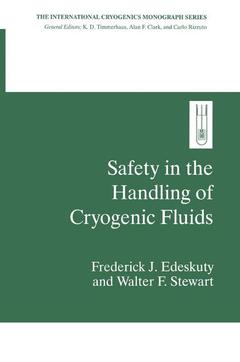Safety in the Handling of Cryogenic Fluids, Softcover reprint of the original 1st ed. 1996 International Cryogenics Monograph Series
Langue : Anglais
Auteurs : Edeskuty Frederick J., Stewart Walter F.

The importance of safety in any scientific endeavor is never in question. However, when cryogenic temperatures are involved, safety is especially important. In addition to observing the normal precautions, one must also take into account the variations of physical properties that occur at low temperatures. At these tempera tures, some properties not only exhibit large differences from their normal values but also can vary widely over a small temperature range. Before any cryogenic project is started, a thorough knowledge of the possible hazards is necessary. Only in this way can the safest operation be attained. Over the hundred-year history of cryogenic research, this has been shown to be the case. Keeping this requirement in mind is an essential ingredient in the quest for accident-free work. The past four or five decades have seen a great expansion of cryogenic technology. Cryogenic liquids, such as oxygen, nitrogen, hydrogen, and helium, have become commonly used in a number of different applications and are easily available in any part of the United States and, indeed, almost anywhere in the world. Not only are these liquids available, they have become less expensive and also available in ever larger quantities. As quantities increase, so also do the conse quences of mishaps. The future seems to hold promise of ever larger and more widespread use of the common cryogens. Thus, the importance of safety also increases as time progresses.
Introduction. Physiological Hazards. Embrittlement of Materials. Stresses Caused by Thermal Contraction. Buildup of Pressure in Closed Systems. Condensation. Combustion Hazards. Combustion Properties. Oxygen Hazards. Slush Hydrogen. Guidelines, Standards, and Regulations. Safety Problems Needing further Investigation. Accidents: Prevention and Examples. Appendix. Index.
This first volume addresses the important safety problems concerning the handling of cryogenic fluids. Authors propose solutions to these problems and discuss the vital concerns that have arisen since the early 1970s particularly large scale handling. They provide tables and descriptions of existing codes and standards, describe the thermal behavior of cryogenic fluids, and discuss cool-down problems of large scale cryogenic systems.
Date de parution : 06-2013
Ouvrage de 234 p.
15.2x22.9 cm
Disponible chez l'éditeur (délai d'approvisionnement : 15 jours).
Prix indicatif 158,24 €
Ajouter au panierThème de Safety in the Handling of Cryogenic Fluids :
© 2024 LAVOISIER S.A.S.



